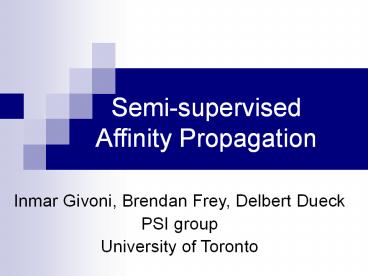Semi-supervised Affinity Propagation - PowerPoint PPT Presentation
Title:
Semi-supervised Affinity Propagation
Description:
Input: pair-wise similarities (negative squared error), data point preferences ... Pair-wise not-in-class nodes for each pair of differently labeled points is ... – PowerPoint PPT presentation
Number of Views:100
Avg rating:3.0/5.0
Title: Semi-supervised Affinity Propagation
1
Semi-supervised Affinity Propagation
- Inmar Givoni, Brendan Frey, Delbert Dueck
- PSI group
- University of Toronto
2
Affinity Propagation
- Clustering algorithm that works by finding a set
of exemplars (prototypes) in the data and
assigning other data points to the exemplars
Frey07
- Input pair-wise similarities (negative squared
error), data point preferences (larger more
likely to be an exemplar) - Approximate maximization of the sum of
similarities to exemplars - Mechanism message passing in a factor graph
3
Semi-supervised Learning
- Large amounts of unlabeled training data
- Some limited amounts of side information
Partial labels
Equivalence constraints
4
Some Motivating examples
5
AP with partial labels
- All points sharing the same label should be in
the same cluster. - Points with different labels should not be in the
same cluster. - Imposing constraints
- Via the similarity matrix
- Explicit function nodes
6
Same label constraints
- Set similarity among all similarly labeled data
to be maximal. - Propagate to other points (teleportation)
- Without teleportation, local neighborhoods do not
move closer. - e.g. Klein02
S(x1,x2)0
x1
x2
y2
y1
7
Different labels
- Can still do a similar trick and set similarity
among all pair-wise differently labeled data to
be minimal. - But no equivalent notion of anti-teleportation.
8
Adding explicit constraints to account for
side-information
9
Adding explicit constraints to account for
side-information
10
Problems
- Lets call all the labeled points portals
- They induce the ability to teleport
- At test time, if we want to determine a label for
some new point we need to evaluate its closest
exemplar, possibly via all pairs of portals -
expensive. - Pair-wise not-in-class nodes for each pair of
differently labeled points is expensive. - Introducing
11
Meta-Portals
- An alternative way of propagating neighborhood
information. - Meta-portals are dummy points, constructed
using the similarities of all portals of a
certain label. - We add N new entries to the similarity matrix,
where N is the number of unique labels.
12
Meta-portals
- mtps can be exemplars.
- Unlike regular exemplars, mtps can be exemplars
for other points but choose a different exemplars
themselves
13
These function nodes force the MTPs to choose
other data points as their exemplars.
Similarities alone are not enough, since both MTP
can choose same exemplars and still have inf
similarities.
14
Some toy data results
15
Future work
- Investigate interplay between modifying
similarities and incorporating explicit
constraints. - Possible tool for user-guided labeling































